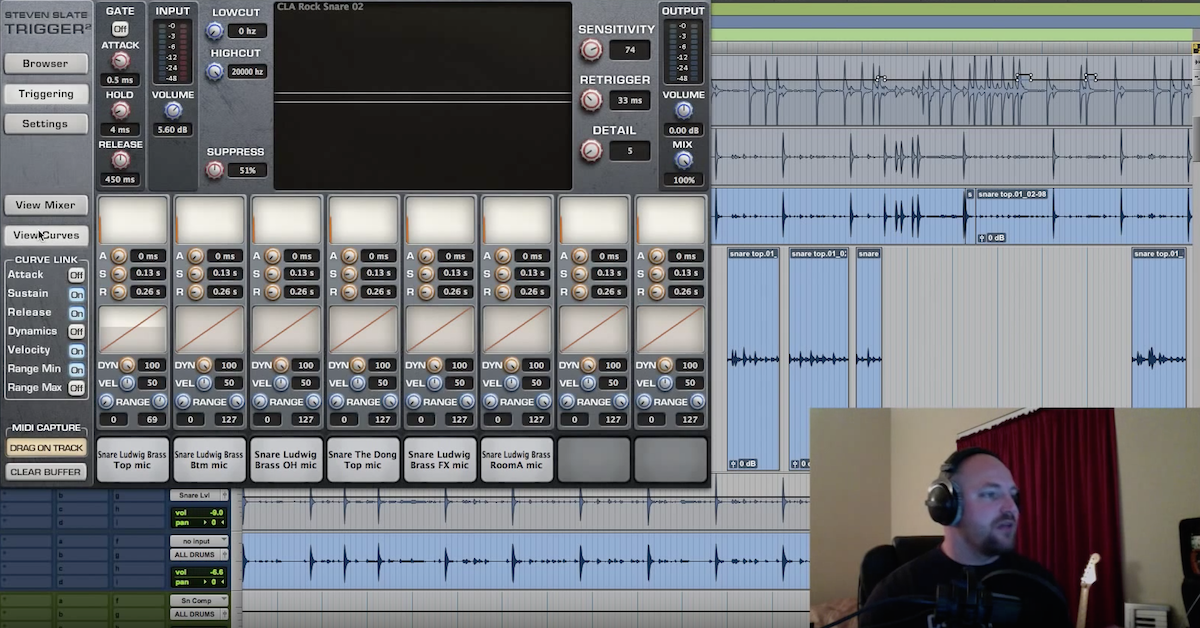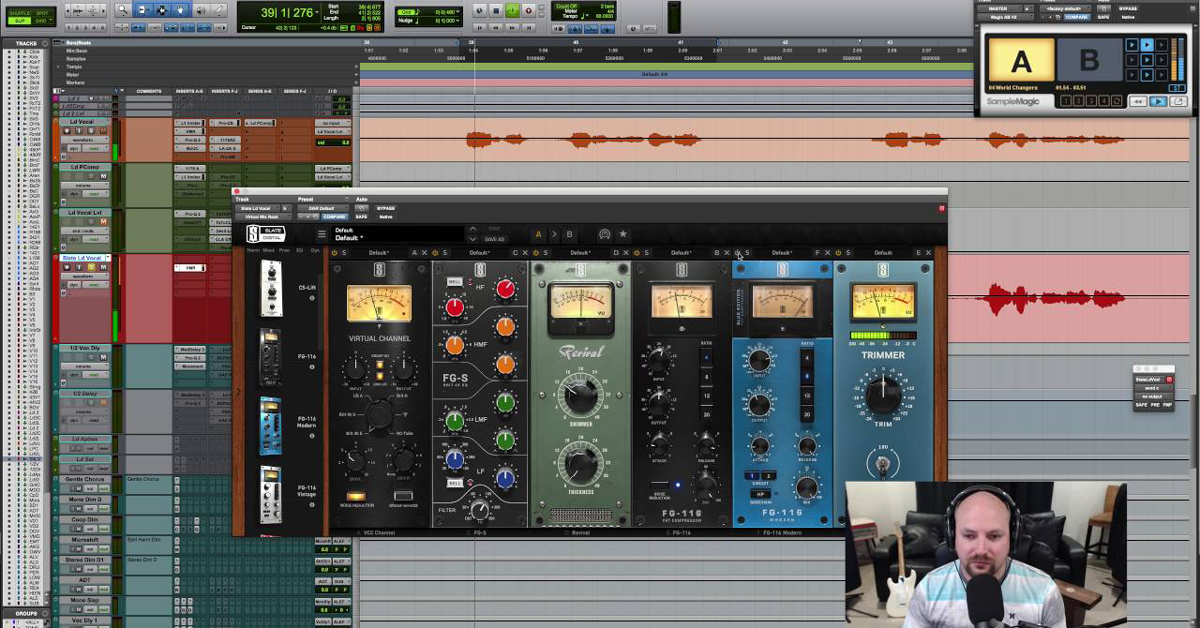70 Mixing Tips From Steven Slate
Article Content
Steven Slate has been dropping knowledge on Twitter for a long time, so I thought I’d round up all his mixing tips and put them on one page for you to read.
Thank him by ReTweeting or checking out some of Slate Digital’s awesome plugins.
Split ur Lead Vox into 3 Copies: 1 Natural, 1 Bright and Compressed, 1 Grainy..automate the 3 throughout the mix to make it POP #protips
— Steven Slate (@Slateproaudio) April 24, 2012
Chris Lord Alge: I always do an automation pass w my drum faders to keep them dynamic in the mix #protips
— Steven Slate (@Slateproaudio) April 25, 2012
The best mastering engineers know when to tweak a mix, & when to leave it alone. Listen before you dive in with the EQ or Comp #protips
— Steven Slate (@Slateproaudio) April 25, 2012
Compressing your reverb returns a bit can thicken them up in a cool way, try it #protips
— Steven Slate (@Slateproaudio) April 25, 2012
Following your delay with a small reverb at 40% wet can mellow it out, and create even more depth #protips
— Steven Slate (@Slateproaudio) April 26, 2012
Digital Peak Limiters are effective for transparently taming overly dynamic acoustic guitars. Try it #protips
— Steven Slate (@Slateproaudio) April 29, 2012
Want a brighter snare? EQ some top into the overheads.. you’ll get there quicker than just eqing the close mic alone #protips
— Steven Slate (@Slateproaudio) May 2, 2012
Dull Vocal Recording? Gently pull out the mud frequencies, compress hard, then add some upper mid eq 4 clarity & air, then De-Ess #protip
— Steven Slate (@Slateproaudio) May 4, 2012
Don’t be afraid to extend the bandwidth of the eq to it’s maximum width.. wider smaller boosts tend to sound more musical #protips
— Steven Slate (@Slateproaudio) April 28, 2012
Carving off some top and bottom of background vox helps them blend in with the lead vox without sounding too defined. Try it #protips
— Steven Slate (@Slateproaudio) May 9, 2012
Wide Bass? Copy Bass to stereo track, hi pass till about 300Hz, distort a bit, send to wide chorus, mix in SUBTLY with dry Bass #protip
— Steven Slate (@Slateproaudio) May 17, 2012
I’ll say it again. Don’t eq your close mic drums until you’ve checked their phase coherency with the overhead mics #protip
— Steven Slate (@Slateproaudio) May 23, 2012
Before you touch the eq or compressor knob, make sure ur brain knows what you intend to do with it, & how it may enhance the mix #protip
— Steven Slate (@Slateproaudio) May 25, 2012
Mellow out ur vocal delays: attenuate using a hi shelf eq at 8k by about 3db, then follow it into a medium room verb at 20% wet #protip
— Steven Slate (@Slateproaudio) May 27, 2012
I always recommend eqing drum overheads and room mics WITHOUT soloing them since they really impact the entire drum sound #protip
— Steven Slate (@Slateproaudio) May 29, 2012
Airy Pop Vox: Hi Pass till 100Hz, boost 12khz 5db, then compress hard @12db, then soak up the sibilance with a strong de-esser #protip
— Steven Slate (@Slateproaudio) June 15, 2012
People like a dynamic song.. automate the master fader a db or so to enhance sections, especially the hooks! #protip
— Steven Slate (@Slateproaudio) May 31, 2012
Over-sibilant vocals make music very harsh when played loud. De-essing properly ensures clarity without being ear piercing! #protip
— Steven Slate (@Slateproaudio) June 18, 2012
Simple kick drum and bass guitar balancing act: cut a small notch of 80Hz in bass, boost a little 80Hz in kick. It WORKS #protip
— Steven Slate (@Slateproaudio) June 25, 2012
ADVERTISEMENT
I almost always automate my master fader up 1.5db on the chorus of the song to help it really pop out #protip
— Steven Slate (@Slateproaudio) July 3, 2012
Rock Kick Trick: Copy kick, filter out deep lows and highs, crank wide bell at 2khz, compress 10db, mix in subtly!
— Steven Slate (@Slateproaudio) July 21, 2012
Rock Snare Attitude: load a ringy snare sample, compress and distort mildly, send to stereo verb, add lows, mix it in subtly to the kit!
— Steven Slate (@Slateproaudio) July 21, 2012
Vintage Vox: Attenuate top w/ 12k shelf, boost mids @ 3.5k, mix in parallel distorted vox subtly, use long predelay’d compressed verb
— Steven Slate (@Slateproaudio) July 24, 2012
Ultimate AIRY Vox w/o being harsh: Copy vox, crank 10khz shelf, then follow with heavy de-essing, heavy compression, mix in to get AIR!
— Steven Slate (@Slateproaudio) July 23, 2012
Vox Delay Tip: If you time out your delay to the tempo of the song, it can add depth without being audible. Start with a quarter note!
— Steven Slate (@Slateproaudio) July 26, 2012
Dry Vox with “life”: Use a stereo pitch shifter, left side 9cents down 20ms, right side 9cents up 40ms, mix in very subtly!
— Steven Slate (@Slateproaudio) July 25, 2012
No matter how much eq or compression you put on your snare.. if it’s not in phase with the overheads, it won’t get punchy!
— Steven Slate (@Slateproaudio) August 22, 2012
Vocal not POPPING out of the mix? Copy it, compress it hard, add some distortion, add some upper mids, mix in SUBTLY with original vox!
— Steven Slate (@Slateproaudio) August 27, 2012
Fat Chorus Guitars: Send guitars to buss. Put compressor on it. During chorus, automate up 2db so that compressor kicks in & fattens em!
— Steven Slate (@Slateproaudio) August 31, 2012
Explosive Poppy Snare: Copy snare, compress heavy with fast attack and release to bring up sustain, gate the tail off, mix in subtly
— Steven Slate (@Slateproaudio) October 22, 2012
Thick Vox: Use stereo pitch shifter 10ms delay and 10 cents up and down on each side, filter off top end, mix in subtly!
— Steven Slate (@Slateproaudio) November 9, 2012
Bigger Chorus Vox: Copy vocal and compress and distort.. mix it in SUBTLY as the hook of the song comes in!
— Steven Slate (@Slateproaudio) December 13, 2012
EZ Parallel Vox Compression: Copy vox, compress one heavy, and during mix, automate the dry vs compressed faders so vox breathes!
— Steven Slate (@Slateproaudio) March 11, 2013
The Big THUMP Snare? Medium tuned Snare w/ big hitter..during mix copy it and crank Lo Shelf at 100Hz 10db! Now compress 5db & mix in!
— Steven Slate (@Slateproaudio) March 5, 2013
Make your vox pop out of the mix: Copy vox, push wide 4khz bell, compress extremely hard w/ fast release, mix in subtly for extra POP!
— Steven Slate (@Slateproaudio) April 24, 2013
Drums need punch & sustain to be BIG in a mix. For punch, little bits of slow attack and medium release compression & upper mid EQ…
— Steven Slate (@Slateproaudio) June 3, 2013
Use a compressor with your ears, not your eyes. I’ll pin the meters on my DRAGON on vox to make them really slam through the mix.
— Steven Slate (@Slateproaudio) June 12, 2013
Super Bright Airy but not harsh POP VOCAL? Crank 10khz hi shelf, follow into compressor with high gain reduction, into heavy de-esser!
— Steven Slate (@Slateproaudio) June 20, 2013
Dynamic & Deep VOX: Try a subtle 1/4 note delay on verse & then bring in a 1/2 note delay w/ feedback on hook. Mellow the delay w/ EQ!
— Steven Slate (@Slateproaudio) June 6, 2013
The faster the song, the less sub lows you’ll want on the kick. Speed Metal? I’ll hi pass up to 80Hz if needed.
— Steven Slate (@Slateproaudio) April 23, 2012
Sizzly Snare Verb: Copy bottom snare trk, filter out lows to 600Hz, crank high shelf at 10Khz, send to nice verb. Nice on ballads.
— Steven Slate (@Slateproaudio) April 19, 2012
Putting a rolled up tape at the VERY edge of the snare drum can dampen the ring slightly without choking the hell out of it.
— Steven Slate (@Slateproaudio) April 19, 2012
If you close your eyes & listen to the mix your brain forces your sense of hearing to heighten. Try it every once and a while.
— Steven Slate (@Slateproaudio) April 17, 2012
Sometimes it’s not about adding more eq or compression or trickery.. it’s just getting the right instrument balance #simple&effective
— Steven Slate (@Slateproaudio) March 28, 2012
Nothing wakes up a kick drum better than making sure its in phase with the overhead mics #there‘smylowend
— Steven Slate (@Slateproaudio) March 7, 2012
Transparent Back Vox that seamlessly blend into Lead Vox: Send BGV to verb, cut some mids & highs, blend verb return only into mix — Steven Slate (@Slateproaudio) February 13, 2014
Massive Kick Trick: Kicks tend to have a dominant sub resonance from 50-100Hz. Sweep a tight bell filter to find it, then reduce & widen! — Steven Slate (@Slateproaudio) April 17, 2014
InstaBig Snare: Send snare to hall verb, gate the verb tightly so decay cuts off at .4ms, eq up the mids, mix in subtly with dry snare! — Steven Slate (@Slateproaudio) April 16, 2014
When u try to get ur mix levels balanced, resonances in ur room can confuse ur ears. Checking levels at quieter volumes is crucial. — Steven Slate (@Slateproaudio) April 11, 2014
Kick drum mic too clicky & thin? Start out by low passing to remove that thin top end junk, then add some mids and lows to fatten. — Steven Slate (@Slateproaudio) April 8, 2014
MASSIVE Bass: Crank 8db @ 60Hz. Follow w/ 10db of medium speed compression. Finalize by hipassing at 30Hz & dip 80hz to let kick breathe — Steven Slate (@Slateproaudio) April 24, 2014
Help your low end breathe & be TIGHT: Hi Pass most non-bassy stuff at 100Hz.. there are exceptions, but it’s a good general rule! — Steven Slate (@Slateproaudio) April 24, 2014
Compression on a vocal is not a substitute for automation. Ride the vocal fader to ensure each part is articulate in the mix! #ProTip — Steven Slate (@Slateproaudio) April 8, 2014
Vox Mix Tip: EQing INTO the compressor allows you to push the upper mids harder to make it cut through the mix without sounding harsh — Steven Slate (@Slateproaudio) February 21, 2014
2 favorite bass guitar tricks: Copy, distort, crank mids, mix in subtly. Send to stereo aux, hi pass @ 300Hz, wide chorus, mix in subtly — Steven Slate (@Slateproaudio) February 13, 2014
How To Check Drum Phase: 1. Solo Overheads. 2. Solo each close mic. 3. Hit phase button. 4. Whichever polarity has more lows, WINS. — Steven Slate (@Slateproaudio) January 7, 2014
Try copying a vocal, adding some subtle distortion, & then SUBTLY blending it back in to the dry vocal. It’ll add fatness and warmth. — Steven Slate (@Slateproaudio) November 15, 2013
Deep Breathing Vocal Effect: Copy Vox, crank 10khz shelf, Compress 20db, De-ess, mix in subtly or even automate in as needed — Steven Slate (@Slateproaudio) November 4, 2013
Fat Kick Drum Tip on Electronic or Rock: Use Stereo Pitch Shifter on aux, 10 cents down/up on each side w/ NO DELAY.. mix in very subtly — Steven Slate (@Slateproaudio) November 4, 2013
MixTip Monday: Take time to IMAGINE the final mix’s sound in your mind.. then TWEAK to get it there. Mix with purpose. — Steven Slate (@Slateproaudio) September 30, 2013
MixTip Monday: Compressing drum room mics with fast release makes the drums bigger w/ more sustain. Slow release makes them tighter. — Steven Slate (@Slateproaudio) September 17, 2013
Mixtip Monday: Extend ur snare sustain by multing it, compressing with fast attack & fastest release, 6db gain reduction, mix in subtly — Steven Slate (@Slateproaudio) September 9, 2013
If you add too much top end to your drums, they will lack body in the mix and sound thin.. Beware of the deadly SOLO button! — Steven Slate (@Slateproaudio) August 13, 2013
The best way to get midrange balances right (such as vocals to guitars).. is at low listening volumes! Try it! — Steven Slate (@Slateproaudio) August 12, 2013





